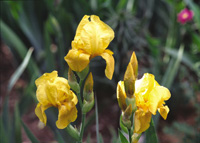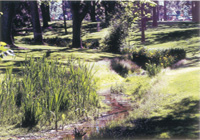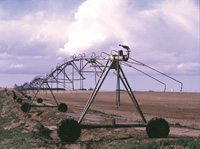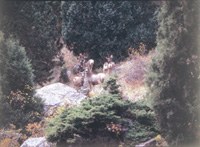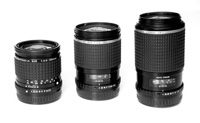The Pentax 645N
Expanding The Telephoto Lens Line Up
|
With the recent addition of the 150mm f/2.8 autofocus lens, the line-up of telephoto or long focus optics for the Pentax 645N camera is nearly complete. When the 645N was first introduced, Pentax promised that they would issue a line of autofocus lenses (labeled FA lenses) equivalent to the manual focus lenses (labeled A lenses) that had previously been available for the Pentax 645. That has been essentially accomplished for lenses longer than the normal 75mm lens, with the exception of an autofocus version of the 600mm f/5.6 SMC A lens. The line of long focus autofocus (SMC-FA) lenses and their specs are listed in the accompanying sidebar (last paragraph). In this report we will concentrate on the two medium telephoto FA lenses; the 150mm f/2.8 and the 200mm f/4. Both lenses are beautifully constructed and give outstanding images. It would be a difficult task to choose only one of these medium telephoto lenses. |
|||
Lens Operation Both lenses use Internal Focusing (represented by IF in the Pentax lens lists), thus do not change length when focusing. The focusing ring is a very wide, rubber surfaced, knurled ring. When the ring is slid toward the back of the lens, manual focus is chosen, and in such a case, these are among the smoothest and easiest focusing lenses you'll ever try. When the focusing ring is slid away from the camera, autofocus is chosen, and a label to that effect is displayed. This operation is the same as with other 645 FA lenses, except the 75mm normal lens, which has a separate lever to select auto or manual focus. In autofocus, these lenses focus rapidly, smoothly, and quietly, for superb autofocus operation, closely comparable to 35mm autofocusing. Both lenses include excellent, efficient (and rather long) sunshades which bayonet onto the front of the lens. When not in use, these can be bayoneted backward on the lens, to make a compact package. |
|||
The 150mm f/2.8 Despite the size difference, the new 150mm lens is essentially the same weight as the older 150mm. The new lens mount had to be totally redesigned, which is one reason why it took a bit of time to introduce the 150mm f/2.8. Autofocusing requires smooth, low-torque focusing, which would be extremely difficult to obtain with a helical mount for a lens this long. For autofocus lenses, internal focusing or front lens element focusing is better. All Pentax 645N prime lenses of 150mm or longer use internal focusing. Internal lens focusing requires a different construction of the lens, to provide for moving elements between some of the inner lens elements. The design can be made to give closer focusing than is typical for helical focusing lenses. The new 150mm f/2.8 lens focuses to 3.9 ft, considerably closer than the 4.6 ft minimum distance of the 150mm f/3.5. One other fact for comparison--at the closest focusing distance, the 150mm f/3.5 extends out considerably, so it is only about 7mm shorter than the 150mm f/2.8. The f/2.8 autofocuses a little better in dim light than a slower lens (such as the 200mm f/4). The price of this lens is about $1050, nearly twice that of the 150mm f/3.5. Yet this is only about 1/2 of the price of similar lenses from some other manufacturers. It is essentially the lowest priced 150mm f/2.8 available for medium format. |
|||
In typical applications, the 150mm f/2.8 lens performed extremely well. The speed and sharpness made its use a pleasure. The lens works well for indoor or other dim light exposures, especially with ISO 400 or faster film. Sharp pictures can be made handheld with the lens wide-open at speeds as slow as 1/60 sec, although 1/125 sec is preferable, if possible. Yet, in brighter light, and with somewhat slower film, extraordinary sharpness in the images is the rule. This is a particularly good lens for candid photography or tightly framed portraits. The 200mm f/4 The 200mm lens was also a redesign from the helical focusing SMC A lens mount to an internal focusing mount on the FA lens, and from a four-element lens to a six-element lens. Closest focus for the newer lens is 4.9 ft rather than the 6.6 ft of the earlier lens. The maximum aperture remains unchanged, and the filter size remains at 58mm. The minimum aperture of f/32 might come in handy at times. |
|||
In use, the 200mm FA lens was just as impressive as the 150mm FA lens. The pictures were sharp and brilliant at all apertures. The convenient size and weight of the lens, along with the speedy autofocus operation, made rapid and accurate photography possible. I used this in much the same way I use a 135mm lens on a 35mm camera, although this 645 lens has a wider angle of view. I wouldn't use this lens in a tight space, like a busy city street; but where there is a little elbow room, this can be a useful lens to tighten the composition. Of course, depth of field can get to be a problem with lenses of 200mm or so. I would tend to use an ISO 400 film if I were using the 200mm lens often, whereas, with the 150mm lens, I would be confident in using an ISO 200 film. Lens Resolution Tests Camera & Lens Performance |
|||
Data Recording If you are interested in these lenses, how can you decide which is best for your use? You could easily face the same question with lenses for any one of the other excellent medium format cameras. Trying both lenses for a while would be the best way, but few of us have that privilege. A comparison to 35mm lenses, as discussed earlier, may be helpful. If you have no other long lenses beyond the 75mm, then I would recommend getting the 150mm to provide a good capability for medium distances and portraits. The jump to 200mm would be quite a large one. If you expect to take many long distance photos, the 200mm, or even a 300mm, might be your best choice. However, anything longer than 200mm is going to cost you over $2000. Remember that these are not primarily bird or wildlife lenses. Usually, you need significantly longer lenses to get the large images sought for that kind of photography. These are lenses for getting larger images of people interacting, for formal or informal portraits, for candid photography, for certain kinds of scenics, and other similar applications. In some respects, one of these lenses would be preferred almost as a normal lens in order to give the tighter framing and larger images that command the viewers' attention. With any size camera, it is a wonderful exercise to spend a few hours taking pictures with a medium telephoto lens in order to train your eye to get those wonderful, well composed, sometimes intimate photographs. Either of the lenses described here have the high quality optics and dependable, responsive mechanics that can lead you to superb pictures. Either the 150mm or 200mm lens would give good medium telephoto capabilities, without the considerably higher price of still longer lenses. Comparing AF & MF Lens Pricing For more information, contact Pentax at www.pentax.com. |
- Log in or register to post comments

